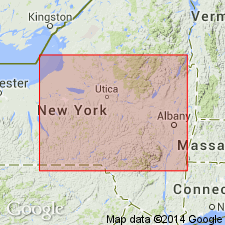
- Usage in publication:
-
- Cayugan period
- Cayugan group
- Modifications:
-
- Original reference
- AAPG geologic province:
-
- Appalachian basin
Summary:
Cayugan period or group. Includes Manlius limestone, Rondout waterline, and Salina beds, which are knit together by lithologic and faunal characters and are distinctly Ontaric [Silurian]. Outcrops are typically exposed about north end of Cayuga Lake, New York.
Source: US geologic names lexicon (USGS Bull. 896, p. 379-380).

- Usage in publication:
-
- Cayuga group
- Modifications:
-
- Overview
- AAPG geologic province:
-
- Appalachian basin
Summary:
In 1903 (Amer. Geol.) C. Schuchert redefined Rondout, restricting name to upper part and introducing Cobbleskill limestone for lower part of the beds formerly called Rondout. The Cayuga group (or Cayugan) has, therefore, for years been divided into these four formations; but G.H. Chadwick in 1908 (Sci., n.s., v. 28, p. 347, table and text) excluded Salina formation from his Cayugan, while E.O. Ulrich in 1913 recommended the transfer of Rondout to Lower Devonian. This is still an open question. (See further explanation under Manlius limestone.) At present [ca. 1938] the USGS adheres to the old classification for New York. In Pennsylvania and Maryland the Cayugan group is divided into (descending) Tonoloway limestone, Wills Creek shale, and McKenzie formation. In southwest Virginia the Cayuga deposits are not differentiated and the rocks are called Cayuga limestone.
Source: US geologic names lexicon (USGS Bull. 896, p. 379-380).
- Usage in publication:
-
- Cayuga
- Modifications:
-
- Overview
- AAPG geologic province:
-
- Appalachian basin
GNU Staff, 1991, GNU Staff remark by E.D. Koozmin. Use of Cayuga or Cayugan.: U.S. Geological Survey Digital Data Series, DDS-6, 1 CD-ROM., release 3
Summary:
The name Cayuga comes from Cayuga Lake, New York. The New York Geological Survey has restricted its use to a time-stratigraphic term in New York (Cayugan series). GNU records indicate that this usage was also adopted by the USGS for all of its reports in New York. The records are unclear as to the year this policy took effect. However, in both USGS and non-USGS reports, the use of Cayuga as a rock-stratigraphic term continued, but probably should not have been allowed. The restriction of use in the unit's type locality in effect preempts usage in other States as a rock-stratigraphic term. (Marjorie MacLachlan, 1991, GNU-Denver, oral communication)
Source: GNU records (USGS DDS-6; Reston GNULEX).
For more information, please contact Nancy Stamm, Geologic Names Committee Secretary.
Asterisk (*) indicates published by U.S. Geological Survey authors.
"No current usage" (†) implies that a name has been abandoned or has fallen into disuse. Former usage and, if known, replacement name given in parentheses ( ).
Slash (/) indicates name conflicts with nomenclatural guidelines (CSN, 1933; ACSN, 1961, 1970; NACSN, 1983, 2005, 2021). May be explained within brackets ([ ]).

